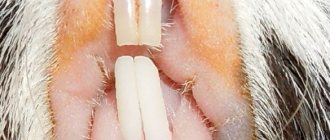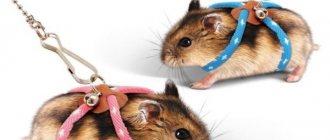- home
- General information
10/21/2018 The hamster is one of the miniature representatives of the rodent family. Before getting a pet, it is very important to study its anatomy. This way you can better understand how to care for it without causing damage to your health. The animal has a fragile body structure, so it must be carefully supervised.
The anatomy of a hamster is similar to other mammals, but there are some differences.
Anatomy of the Syrian hamster
A distinctive feature of hamsters is the presence of cheek pouches. They are located on both sides of the jaws. The bottom of the pouches is located near the shoulder joint. They use them to carry food to secluded places. If the pet completely fills these bags, its head will double in size. It extracts food from its cheek pouches using its paws. The bags can hold 18 g of food or more.
The animal can use its cheek pouches as defense. If danger approaches, he inflates them with air, which makes them seem scarier.
There are 16 teeth in the oral cavity. Of these, 12 are molars for chewing food and 4 are incisors. A characteristic feature of the rodent family is the absence of fangs. There is a void (diastema) between the incisors and chewing teeth.
The animal's incisors are constantly growing, so it is necessary to give the pet wooden objects and solid food. If the incisors are not ground down, they will reach large sizes. Then it will be difficult for the animal to close its mouth and chew. Subsequently, you will have to contact a veterinarian for an operation to shorten the incisors.
The hamster's skeleton is identical in structure to other mammals, but the bones are very fragile. If the animal jumps or falls from a height, it will break limbs and may damage internal organs. Hamsters are active animals; they love to climb heights, so they often have broken legs.
The structure of the internal organs is similar to other animals. A distinctive feature is the structure of the stomach (two-chamber), consisting of 2 sections:
- The function of the front is to soak food.
- Digestion occurs through the glandular section.
The distance from the anus to the genitals will help determine the sex of the animal. In females it is 3 mm, in males it is from 1 to 1.5 cm.
Other interesting anatomical features of funny rodents
Dentofacial apparatus
The number of teeth in a hamster is 16 (8 on the upper jaw and 8 on the lower, with the number of incisors being 2 each on the upper and lower jaws, and the number of molars being 6 each). Incisors do not have roots, due to which they have the ability to grow throughout the life of the animal. These teeth are covered with yellow enamel, which prevents excessive wear of the incisors.
Lateral glands for marking territory
Like many other animals, hamsters have special organs that secrete a special secretion. These organs in a hamster are the lateral glands, located on the back behind the ears and representing two inconspicuous black dots. The secret secreted by this organ allows the hamster in the wild to mark its territory and participate in the race for females.
Anatomy of the Djungarian hamster
The Djungarian hamster can be distinguished from the Syrian by the presence of hair on the limbs, by the color of the hair, and by the gray stripe that runs from the head to the tail. The Dzungarian hamster grows up to 10 cm in length, and the Syrian hamster up to 20 cm. The Dzungarian hamster bears the fetus in 19–22 days, and the Syrian hamster in 16 days. In the female, the uterus is divided into 2 parts.
Hamsters have identical ears. They perform the functions of hearing, coordination and maintaining balance.
Animal skeletal system
Hamsters have very fragile bones and structure. Their musculoskeletal system does not tolerate collisions, shocks and blows well, which is why hamsters have broken legs.
Features of the structure of the paws
The animals have small but very powerful paws in front. With their help, the fluffies dig up the ground. There are 4 fingers on the limbs, there is also a 5th, but it is undeveloped. The legs at the back are weak, they are used to throw the excavated soil behind the back.
In Syrian and Djungarian hamsters, all 5 fingers are normally developed.
What is a hamster's body temperature?
The normal body temperature for the animal is 37.5–38.5 degrees. It is measured rectally. It can be low or high. A low temperature indicates the presence of infection. In this case, you should use a heating pad with warm water wrapped in a cloth and apply it to the animal’s body. The heating pad must be kept on for 10 minutes, then wrap the animal in a warm towel and contact a veterinarian.
An elevated temperature also indicates the presence of an infection in the body. In this situation, the rodent should be placed near a windowsill or refrigerator where there is a cool place. Don't put off visiting the veterinarian.
Hamsters, hamsters: maintenance, feeding, body characteristics
Hamsters are crepuscular animals. This means that only in the evening do they become truly alert. This circumstance must be taken into account when purchasing a hamster. During daylight hours, the hamster retires to its hole and sleeps. The optimal temperature for a hamster is between 21-25°C. At temperatures below 10°C they go into hibernation.
Hamsters need a very durable wire cage because they chew through all other materials. The wire should lie horizontally so that the animals can climb around the cage. Due to the fact that hamsters are solitary animals and often do not get along together, it is recommended to have only one hamster. It is enough to have a cage measuring 25 cm in length, 25 cm in depth and 20 cm in height.
As burrow dwellers, hamsters are very fond of a sleeping place, which should be filled with cellulose in which the hamster could burrow. To provide the hamster with the ability to move in the cage, you need to place a wheel in it.
The hamster can also be kept in a terrarium. However, with the help of branches it is necessary to provide him with the opportunity to move sufficiently. The top of the terrarium must be covered with wire mesh so that the hamster cannot jump out. If you let the hamster run free to satisfy the need for movement, then you need to constantly look after him. Golden hamsters chew their way not only through books and linen, but also through upholstered furniture, from where they then cannot escape.
Striped hamsters naturally move much more than golden hamsters and therefore require much more freedom of movement. Thus, the cages of the Chinese striped hamster must be larger and equipped to allow the animal to move more (than the golden hamster).
Breeding
The fact that hamsters kept together often do not get along very well must be taken into account when breeding hamsters. To breed hamsters, they need to be kept at the rate of one male for every 5 females, and each animal needs a separate cage. The female cages are placed around the male cage. The male cell is connected to the female cells using connecting pipes. The diameter of the pipes should be such that the hamster can easily move along them (4 cm). Females need a collar made of synthetic material, the diameter of which is larger than the internal diameter of the connecting pipes, so that only the male can get from one cage to another, and females cannot get out of their cages. This ensures that there are no fights between animals.
Pregnant females must have a special birthing cage.
The duration of pregnancy is 18 days, the female gives birth to up to 10-12 cubs, which are born blind and naked.
A baby hamster weighs 2-3 g at birth. It is naked, its eyes and ears are closed. Teeth are already developed at birth.
Hamsters' ears open on the 5th day, their eyes on the 15th. At the age of 21 days, when they can be weaned from their mother, they weigh 35-40 g. After 6-8 weeks they become sexually mature.
As soon as the little hamsters open their eyes, they begin to explore the world around them. At the same time, the female drags them back to the nest again and again. Hamsters recognize each other by smell. Females and males have glands on their sides that secrete an oily secretion. In males these glands are larger. The fatty secretion serves to mark the area. The male rubs these glands on the grass and branches of his area in order to leave the secretion of the fatty glands on them. He also rubs himself with the secretion of these glands in order to distribute his specific odor throughout the body. During the raising of the cubs, it is not recommended to change the upholstery of the burrow where they live. small hamsters are the first “home impression”
Feeding hamsters
When professionally keeping hamsters, they are fed with food intended for mice and rats. This food contains 16-24% proteins, about 60% carbohydrates and 5% fats. Hamsters need 5-7 g of this food with a weight of 100 g. If the hamster is kept at home, it can be given food for hamsters, which is sold in stores This food can be enriched and supplemented with fruits, vegetables, dandelion leaves and other herbs, as well as salad Hamsters love raw meat, but they should receive muscle tissue no more than 1-2 times a week in small portions Animals should always have fresh drinking water at their disposal. Learn more about feeding hamsters.
Because hamsters store food in their burrows, their sleeping hut should be checked from time to time. Grain supplies can be left in the hut, and fruit and other perishable foods should be removed to prevent the formation of mold and rot.
3.3 Physiological data Body temperature 37.5-38.5'C Respiration rate 33-127/min Pulse 280-412/min. Sexual maturity of males 6-8 weeks Sexual maturity of females 8-12 weeks Duration of pregnancy 15-18 days Number of cubs 4-12 cubs Life expectancy 2-3 years Blood composition indicators hemoglobin 16 g/dl hematocrit 40-50% red blood cells 7.5 x lO " /mm3 leukocytes 7.6 x 103/mm3 Hemogram lymphocytes 75% monocytes 3% neutrophils 30% eosinophils 1% basophils 1% bilirubin 0.5 mg/100 ml glucose 120 mg/100 ml creatinine 0.5 - 0.6 mg/100 ml 3.4 General examination and special examinations Recommendations for a general examination can be found in Chapter 7 1 • Sex determination In an adult male hamster, relatively large testicles can be clearly distinguished. In newborns or small hamsters, the sex can most reliably be determined by the distance between the anus and genital opening. In males, this distance is greater than in females.
Taking blood
Cardiac puncture as a method of drawing blood is recommended to be used only by experienced veterinarians, and the animal must be under anesthesia. The risk of fatal pericardial tamponade is great. Easier to learn and less dangerous is the method of taking blood from the venous plexus of the orbit. The animal must also be anesthetized. The head is held between the thumb and forefinger, with the thumb directly behind the lower jaw blocking the jugular vein by pressing, while the upper eyelid is pulled back with the index finger and slight exophthalmos is caused by pressing. Using a capillary tube at the anterior corner of the eye, the venous eye cavity is damaged.
After a blood vessel ruptures, the blood rises through the capillary tube. After the capillary tube is removed from the eye and the thumb is removed from the jugular vein, the bleeding stops.
Another way to collect blood is to take blood from the tip of the tail. This method of taking blood is the simplest, but here you can often encounter disagreement from animal owners. An incision is made at the tip of the tail using scissors. With this method of drawing blood, it is also recommended to use a capillary tube, since due to blood clotting, bleeding quickly stops.
A small amount of blood is also taken by cutting off the nail at the nail bed • Urine and fecal examination, skin examination A detailed description of these types of examination can be found in Chapter 1.4, in the “Guinea pig” section.
X-ray examination
The duration and strength of exposure for x-rays of a hamster depend on the cassette used, as well as the type of exposure and development method. To avoid the need to manually restrain the animal and to prevent interfering lead gloves from appearing in the photo, you can place the hamster in a small box.
Anesthesia
For surgical interventions, the use of injection anesthesia with ketamine and xylazine has proven itself in practice. To do this, ketamine (150 mg/kg body weight) and xylazine (5 mg/kg body weight) are taken into one syringe and an injection is made. When injecting intramuscularly, care must be taken to ensure that only a small amount of liquid is injected into one area, as the tiny size of some muscles can easily damage them or the nerve fibers passing through them. After approximately 3 minutes, the animal falls on its side, and after 6-8 minutes, surgery can begin. The duration of the surgical anesthesia stage is 30 minutes, the duration of the awakening stage is approximately 4 hours. For this type of anesthesia, vagolytic premedication with atropine is not required, but it can be performed to maintain the main injection (0.5 mg/kg body weight, subcutaneously).
Another possibility is a combination of ketamine and Nembutal. To do this, an intramuscular injection of ketamine is given at a rate of 150 mg/kg body weight and Nembutal at a rate of 50 mg/kg body weight. However, when using this type of general anesthesia, care must be taken to ensure that the animals do not become hypothermic; during the period of awakening, they must be placed under an infrared lamp.
Inhalation anesthesia, which is less recommended in a veterinary clinic, is done using a cotton-gauze mask, onto which halothane is dripped, and then applied to the animal’s face. In this case, you need to ensure that the cotton wool soaked in halothane does not touch the nasal mucosa, as a skin reaction may begin. The depth of anesthesia can be adjusted by removing the mask, reducing the concentration of the inhaled mixture. With this form of anesthesia, it is necessary to carry out vagolytic premedication with atropine (0.5 mg/kg body weight).
For laboratory animals, there are special anesthesia devices for inhalation anesthesia, as well as intratracheal tubes, which are unlikely to be used in veterinary practice due to their high cost.
Another option for anesthesia is the combined use of ketamine and methoxyflurane.
After injection of ketamine (150 mg/kg body weight), the hamster is placed in a vessel containing a swab soaked in methoxyflurane. The depth and duration of anesthesia can be easily adjusted using a methoxyflurane-impregnated swab. Since there is no strong salivation with this type of anesthesia, premedication with atropine can be abandoned.
During the awakening period, hamsters are very susceptible to lower temperatures. Therefore, after surgery, they must be placed under an infrared lamp or on a heating pad, and the animal's internal body temperature must be monitored until it reaches 38°C.
Does a hamster have a tail?
If you look closely, you will notice that the animal has a small tail. Depending on the type of animal, the length of the tail ranges from 7–10 mm. In a fit of rage, the female can bite off the tail of the male.
The animal needs a short tail to protect the anus from pathogens. Wet tail disease is common among hamsters. One of the reasons is diarrhea, which appears due to poor quality food, unsanitary conditions in the cage and dirty water. In 90% of cases, hamsters die from the disease if they do not contact a veterinarian in time.
A hamster needs a tail to move and balance.
What does a hamster look like?
The family includes small, tightly built animals with short but developed body parts.
The body length of hamsters depends on the specific species and sex and can be from 7 to 35 cm. The length of the tail usually does not exceed 10 cm. Sexual dimorphism in size is widespread in hamsters (females are often larger than males). The back color varies from off-white to brown, and the belly color ranges from white to black. You can find individuals with a pronounced black stripe running across the entire back. Some species of hamsters have distinct pouches for carrying food.
In this article we will take a closer look at the physiology of the most popular hamster species. Interesting? Read on!
How is a mouse different from a hamster?
A mouse differs from a hamster in appearance. The main differences are:
- The length of the tail in a mouse reaches the size of the body itself; in a hamster it is very short, almost invisible.
- The skull has a special structure, so the muzzle of a mouse is elongated and narrow, while that of a hamster, on the contrary, is wide and flattened.
- The mouse’s body is elongated and thin, while our pet’s is short with thick fur, which visually creates a rounded shape.
- The coat color of rodents is different. In a mouse, gray and white colors predominate; in a hamster, they are multi-colored (red, black, white, spotted).
The hamster and the mouse are related and belong to the rodent family.
The lifespan of hamsters is from 2 to 3 years. The weight of an adult animal is about 130 g. Hamsters have brains, but they are not able to recognize their owner. To do this we use our sense of smell. His brain cannot perform complex activities, but can be trained.
Hamster diseases - diseases of the nervous system
Lymphocytic choriomeningitis in hamsters
Lymphocytic choriomeningitis in hamsters is a very serious disease that is infectious in nature. Affects all organs.
- reasons - an animal can become infected through contact with a sick individual. The main carriers of this disease are mice;
- symptoms - appear almost immediately and are expressed in general weakness, difficulty breathing, body temperature increases;
- treatment is a disease, unfortunately incurable. If your pet has become a victim of lymphocytic choriomeningitis, measures should be taken to euthanize the hamster. This is the only way to put him out of his misery.
Important! All hygiene rules must be followed; this disease can be transmitted to humans.
Aujeszky's disease - what is important to know about this disease of hamsters
Aujeszky's disease - this disease is often called “false rabies”, since they have similar symptoms.
- reasons - the causative agent of this disease is a virus that affects the entire nervous system of the hamster;
- symptoms - signs of the disease do not appear immediately, but only after two to three weeks after infection. The disease manifests itself in increased excitability of the animal and the presence of itching;
- treatment - it is possible to cure Aujeszky's disease only in the early stages, if the disease is advanced, the virus covers the hamster's vocal cords, provokes the development of laryngeal paralysis, as a result of which the animal dies.
Characteristics
Most rodent lovers want to know everything about Siberian hamsters. The presence of features in behavior and characteristics is expressed by the following criteria:
- Siberian hamsters are called white Russian dwarf hamsters because of the special property of changing the color of their coat: from gray to white in winter;
- adults lead a calm and slow lifestyle in relation to the young;
- Siberian hamsters are mainly nocturnal. With the onset of darkness, which serves as protection for them from encounters with insidious predators - foxes and owls, they go out in search of food.;
- orientation in space with the help of whiskers allows animals to determine the width of loopholes and the distance between objects;
- rodents easily recognize each other by the smell of the marked territory;
- different-sex individuals of the breed live together only during the mating season, and the rest of the time they live separately and protect their homes from encroachment by other animals;
- with the onset of three months of age, females are able to reproduce with a gestation period of 19 days.
Source
Distribution and reproduction
The wild hamster is a very unpretentious animal ; it is not afraid of arid steppes, mountains, forests, or proximity to humans. Distributed almost everywhere, from Europe to China.
The pest is not afraid of the harsh climate. He takes refuge safely in his hole. The main thing for rodents is to have something to eat, so they usually settle near fields and gardens.
They get close to dachas and villages to make supplies from the harvest in their gardens. Farmers are suffering from these pests everywhere, inventing new ways to combat them.
One male usually creates families with several females. The cubs are born blind and bald, but they grow very quickly and soon become involved in the process of replenishing the population.
A female wild hamster gives birth in the spring, and can sometimes give birth several times a year, under favorable conditions. They reproduce exponentially, with litters usually ranging from 6 to 18 cubs .
Temperature regime of hamsters
The optimal temperature for a hamster to live is 17-22 degrees. Its life is also affected by fluctuations in temperature, humidity and amount of light. You should not keep your hamster's cage on the floor, especially in winter. It can be blown through by any draft, and the temperature there fluctuates constantly. Such living conditions can lead not only to illness, but even to death. It's better to put it on the nightstand or at least for some promotion. The brightness of the light affects the animal. Do not forget that these are nocturnal animals; they avoid daylight. This is why hamsters sleep all day.
Remember what temperature hamsters live at when they hibernate. This happens when the temperature drops below 10 degrees. Therefore, you should not allow such temperatures where the hamster lives. A domestic hamster will not be able to hibernate, and the cold is very harmful to it. Even though they tolerate it more easily than heat. Make sure that it is not hot, especially in stagnant air and high humidity, this can cause your pet to overheat and heatstroke. As a result, immunity will decrease, the activity of the rodent will decrease, and loss of appetite. In the summer, regularly ventilate the room with the rodent cage. Since drafts are harmful to him, it is better to take your pet to another room at this time. Do not keep your pet in a garage or other place where it can be exposed to air. 17-22 degrees should be stable. If the temperature regime is violated, it will not last long. In closed cages the temperature and humidity differ from room temperature. Therefore, they need to be ventilated often. It would be nice to equip the cage with a thermometer. High humidity combined with low temperature has a detrimental effect on hamsters. People can also feel this; at this time the cold is felt much stronger. High temperatures greatly harm the health and immunity, especially of pregnant rodents. This can cause toxicosis in them.
Lifestyle
Many people also know from cartoons that a hamster is a thrifty animal. He is a good owner who works all summer. Around August, he begins to make global reserves to provide himself with food for the entire winter and spring. To preserve food, the common hamster digs long burrows of varying lengths. It has many passages and chambers, designed separately for a nest, several storerooms, a winter hut, a bedroom, and a dining room. In total, the length of all its corridors can be about 8 meters. All the chambers are located deep enough so that nothing happens to the animal’s treasures in the cold. Sometimes an ordinary hamster can take over a gopher's hole and settle there. In addition to collecting supplies, the animal keeps its bedding clean and regularly replaces it with fresh ones. With the onset of frost, the animal hibernates, waking up from time to time to refresh itself.
This animal is aggressive and does not tolerate the proximity of its relatives. If another hamster wanders into his territory, he will fight with him. It is known that, protecting the entrance to its burrow, this “fluffy” can attack not only predators, but even humans, and at the same time it is capable of painfully biting. But, despite such courage, the animal may die, becoming the prey of a ferret, fox or bird. He is able to run fast and jump sharply, but if he is calm, he walks quite slowly. Basically, the hamster begins to fuss and leave the hole only when evening comes. At dawn he goes to the shelter. An ordinary hamster spends his entire day there. The photo below shows the animal resting in a hole.
What do they eat at home?
Hamsters will eat whatever you give them. But don’t feed them everything - the food we are used to can be deadly for these rodents.
Dry cereals are useful for a hamster: buckwheat, oats and rolled oats, barley, legumes, as well as nuts, sunflower and pumpkin seeds. Rice is given extremely rarely.
Provide the presence of fresh herbs, vegetables and fruits - wet food.
Important! Do not give your hamster fried, steamed, fatty, or salty foods. Human food is not suitable for the gastrointestinal tract of these animals.
Syrian hamster in exercise
What can you give from greens and vegetables?
Green food is an integral part of a hamster's diet.
A suitable option is fresh, young greens of sprouted dry food from the hamster’s main diet. It is advisable to give juicy grass only fresh, and in small pieces.
Hamsters can:
- Salad.
- Parsley.
- Dill.
- Dandelion leaves, plantain.
- Nettle.
- Clover.
- Hay.
Give greens that are clean and grown without the use of fertilizers or chemicals, preferably from a summer house or garden. This herb differs from store-bought herbs in that it contains no toxic contents.
Every other day, pamper your pet with juicy vegetable pieces:
Tomatoes But not all vegetables and fruits are beneficial for these animals. Due to ignorance of the specificity and nutritional properties of vegetation, hamster lovers have questions: can hamsters eat cabbage and pumpkin? Will red beets or hot radishes harm them?
Cabbage is definitely necessary in their diet. It is forbidden to give only the red-headed variety, as it may cause bloating and colic. Cauliflower and broccoli are ideal.
Cabbage in any form is contraindicated for small, immature hamsters!
Pumpkin and beets can be present in your pet’s feeder every day, but it is better to avoid radishes.
Important! Foods that cause bloating and gas formation can cause the death of a pet in 3-4 hours (for example, beans)!
What do you like from fruits and berries?
Hamsters love to eat sweet pieces of apples, bananas, and nibble on fresh currants. Sweet, juicy pieces are sure to delight furbabies.
Beginning hamster owners are faced with many questions regarding their care. In terms of nutrition, questions arise: can hamsters eat bananas, tangerines, pomegranates, grapes, persimmons and other overseas delicacies?
Give a banana no more than once a week, it can cause allergic reactions.
Limit your consumption of pear because it has a laxative effect.
Persimmon is allowed occasionally, and only soft, not very astringent.
Once every seven days, treat your hamster to apricots, peaches; in small quantities you can give raspberries, strawberries, and grapes.
Pomegranate, citrus fruits, pineapples, kiwis and watermelons are not recommended.
In winter, in the absence of such variety, give dried fruits.
Citrus
Allowed to give:
- Currant berries.
- Plums.
- Rose hip.
- Gooseberries.
- Rowan.
- Strawberries.
- Sea buckthorn.
- Cherry.
- Cherries.
- Blueberries.
- Dried apricots.
- Apples.
It is recommended to give berries without seeds!
It is preferable to choose apples of a sweet variety, and they can be introduced into complementary foods from 2 weeks of age.
What else to feed at home?
In addition to the above products, protein foods should be included in the hamsters' menu. In nature, they obtain this building product by eating small insects and worms. You can, of course, provide your hamster with live food, but in most cases this is problematic.
At home, it can be replaced with protein-containing products: chicken fillet, turkey or rabbit, boiled chicken or quail eggs, 2% cottage cheese or low-fat kefir.
Attention! Quail eggs are healthier for hamsters!
Can cheese, milk and dairy products be used as a source of protein? The answer is clear - no. The composition and fat content are not suitable for the gastrointestinal tract of hamsters and cause digestive disorders.
Attention! Opinions about cheese vary. Some sources claim the benefits of this dairy product, others, on the contrary, talk about its harm to the stomach of hamsters. In any case, you should not risk harming your pet, especially since such a possibility exists.
Chicken fillet is cooked without adding any spices or salt.
In specialized stores you can purchase natural sources of protein - butterflies, worms, grasshoppers.
In addition, pamper the animal with fish or shrimp, but in small quantities.
It is good for the teeth to give the animals dried wheat or rye bread. It not only grinds down teeth, but perfectly saturates the hamster and normalizes the functioning of the gastrointestinal tract. Under no circumstances should you give him crackers with added flavors or aromas; they are extremely harmful to his stomach.
Hamster
It is useful to give:
- Nuts: hazelnuts and walnuts.
- Seeds: flax, pumpkin, sunflower.
Vitamins
If your pet eats ready-made food from various cereals, then all the necessary vitamins and microelements are necessarily present there. Their presence must be indicated in the composition.
If your pet's diet is poor and you do not adhere to special rules, then it is better for you to buy special vitamin supplements. They are sold in regular pet stores. You should buy vitamins for hamsters; any others can significantly harm their health.
Temperature regime of hamsters
The optimal temperature for a hamster to live is 17-22 degrees. Its life is also affected by fluctuations in temperature, humidity and amount of light. You should not keep your hamster's cage on the floor, especially in winter. It can be blown through by any draft, and the temperature there fluctuates constantly. Such living conditions can lead not only to illness, but even to death. It's better to put it on the nightstand or at least for some promotion. The brightness of the light affects the animal. Do not forget that these are nocturnal animals; they avoid daylight. This is why hamsters sleep all day.
Remember what temperature hamsters live at when they hibernate. This happens when the temperature drops below 10 degrees. Therefore, you should not allow such temperatures where the hamster lives. A domestic hamster will not be able to hibernate, and the cold is very harmful to it. Even though they tolerate it more easily than heat. Make sure that it is not hot, especially in stagnant air and high humidity, this can cause your pet to overheat and heatstroke. As a result, immunity will decrease, the activity of the rodent will decrease, and loss of appetite. In the summer, regularly ventilate the room with the rodent cage. Since drafts are harmful to him, it is better to take your pet to another room at this time. Do not keep your pet in a garage or other place where it can be exposed to air. 17-22 degrees should be stable. If the temperature regime is violated, it will not last long. In closed cages the temperature and humidity differ from room temperature. Therefore, they need to be ventilated often. It would be nice to equip the cage with a thermometer. High humidity combined with low temperature has a detrimental effect on hamsters. People can also feel this; at this time the cold is felt much stronger. High temperatures greatly harm the health and immunity, especially of pregnant rodents. This can cause toxicosis in them.
So what temperature do hamsters live at? 17-22 degrees. The number of degrees, as well as humidity, should be stable. Do not place the animal in the sun. He prefers a dark corner.
Any questions left?! Find all the answers in the search:
The structure of the Djungarian hamster
by
Mikhail Konovalov 04/30/2019, 22:09
193 Views
Let's look at the structure of the Djungarian hamster in order to be able to provide your pet with the most appropriate care. The skeleton of the dwarf hamster is no simpler than that of other mammals.
Baby's paws
The animal has four legs. The front ones are small, but very strong. When living in the wild, they often dig the ground. There are 5 toes on the paws. Four of them are clearly visible, but the last one is almost invisible, since it is not sufficiently developed, although all 5 toes are visible in Djungarians.
As for the rear pair of limbs, they are less developed. In nature, the rodent throws away the dug soil with its hind legs so that it does not interfere with it.
Behavior and natural instincts
Babies are big sleepyheads, they like to sleep during the day in a cozy hole, and wakefulness begins in the evening and can last all night. You need to remember this when planning to purchase a rodent.
Sociable and charming furries love children and make contact easily. They are practically silent animals and can even be trained. They will never take revenge for an insult; they are affectionate and friendly. The fun starts that they periodically organize in the cage mean only one thing - the hamsters are having fun and they are inviting you to play.
Some aspects of a rodent's behavior may surprise the owner, but it is not difficult to unravel such actions. If a baby funnyly pecks at the bottom of his house, most likely he wants to refresh himself and is looking for food. The fear of an animal can be determined if it suddenly freezes without moving or sneaks around the cage. A funny stance on its hind legs indicates that the baby is very interested in something. It is extremely rare that in this position a Siberian hamster can show his grin and even try to growl - this means that it is better not to touch him, he is aggressive.
If you add a couple or several friends to a hamster, it is best to do this in the first days of life; adaptation will be painless. But if you allow this to happen at a fairly mature age, then friendship between neighbors may not happen. A female and a male can live in the same cage only when you are going to breed offspring. Reproduction occurs quite quickly.
Siberians are very clean; all their free time they are busy with hygiene procedures: washing their paws, brushing their fur.
Oral cavity
The uniqueness of this animal lies in its cheek pouches. These are developed, capacious muscle cavities that begin as slits near the lips inside the mouth, and the bottom is located near the shoulder joint. If these bags are completely filled, the weight of the head doubles.
A rodent also has teeth in its mouth. Some believe that these are only 4 teeth that are visible to the naked eye. In fact, there are more teeth, these are small molars, 6 pieces on each part of the jaw. Their purpose is to grind food.
Source
Harm to a person - a farmer
It’s not hard to imagine the enormous harm wild hamsters cause to agriculture, farmers, gardeners and gardeners!
The huge number of pests and the ability to adapt to any conditions allow them to infest all rich territories, and the ability to build complex burrows makes them difficult to catch and destroy.
Everything that is grown in the garden is a delicacy for them, and hamsters will not give up so easily. Farmers face a serious struggle for their harvest!
In addition, wild hamsters can bite humans or domestic animals and livestock, which will most likely result in infection with various infections (up to 30 types), and possibly death.
The fleas that live on them and suck blood are no less dangerous. Rodents pose a serious threat, but the fight is all the more important!











